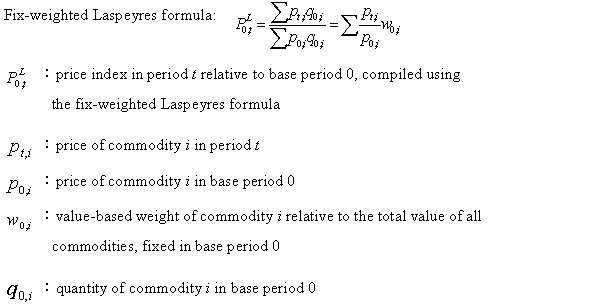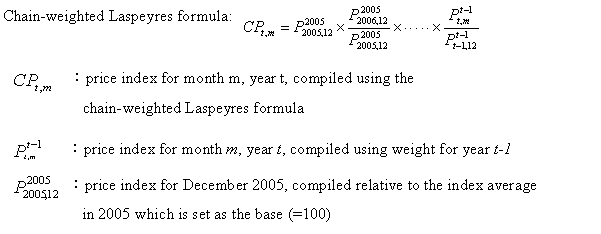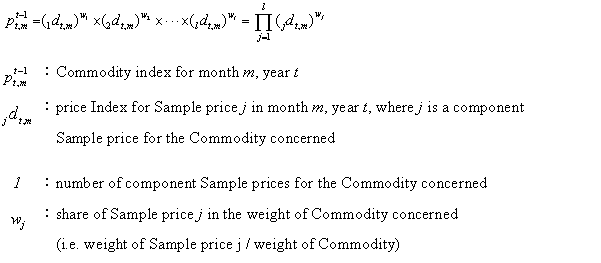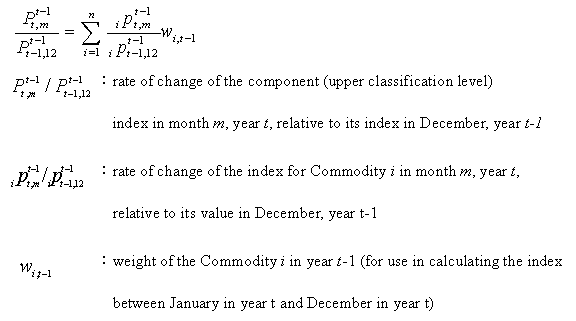Outline of Corporate Goods Price Index (CGPI, 2005 base)
December 2009
Bank of Japan
Research and Statistics Department
1. Purpose and Application
The Corporate Goods Price Index (CGPI) measures the price developments of goods bought and sold by companies. The main purpose of the index is to grasp the supply and demand conditions of individual goods, as well as to provide material for deciding monetary policy. The indexes of less-aggregated levels (e.g., Commodity, Commodity class) not only have a role as deflators that transform nominal output values into real quantities, but they are also useful as references when determining prices for individual transactions.
In accordance with the revision to the 2005 base CGPI, the following indexes--excluding extra charges for summer electricity--are also published as references: Domestic Corporate Goods Price Index (DCGPI); Index by Stage of Demand and Use (ISDU); Domestic Corporate Goods Price Index using Chain-weighted Index Formula (Chain-weighted DCGPI); and Domestic Corporate Goods Price Index excluding Consumption Tax (DCGPI excluding consumption tax).
2. Structure, Classification and Weights
Commodities are classified into three Basic grouping indexes: Domestic Corporate Goods Price Index (DCGPI), Export Price Index (EPI) and Import Price Index (IPI). In response to the needs of research analysts, the BOJ compiles Reference indexes in which Commodities of the Basic grouping indexes are reclassified under different criteria for specific purposes or adjustments are made to the Sample prices (see below) of the Basic grouping indexes.
Basic grouping indexes
Domestic Corporate Goods Price Index (DCGPI)
For the DCGPI, the Bank of Japan (BOJ) surveys the prices of goods traded among companies, specifically domestically produced goods for domestic markets, mainly at the stage of shipment from producers and partly from wholesalers. The weights are calculated using shipments to the domestic market (which are obtained by deducting the export value of 2005 in the Ministry of Finance's Trade Statistics of Japan from total shipments of 2005 in the Census of Manufactures by the Ministry of Economy, Trade and Industry). As for weights which cannot be calculated from the above sources (such as non-manufacturing products), the BOJ uses other statistics published by government agencies or industry organizations accordingly. The DCGPI is classified into 5 Major groups and further classified into 22 Groups; it is compiled including the consumption tax.
Export Price Index (EPI) & Import Price Index (IPI)
Prices of exports at the stage of shipment from Japan are surveyed for the EPI, while those of imports at the stage of entry into Japan are used for the IPI. The indexes are published on both a yen basis and a contracted currency basis. The value of exports and imports of 2005 (from the Trade Statistics of Japan published by the Ministry of Finance) are used for calculating the weights. The EPI and IPI are classified into 8 Groups and 11 Groups, respectively.
Reference indexes
Index by Stage of Demand and Use (ISDU)
This index is compiled by reclassifying the DCGPI excluding the consumption tax (see below), EPI and IPI in terms of Commodities' stage of demand or use of goods. It is used to analyze various price developments, such as how a price change in one stage affects that in other stages.
Domestic Corporate Goods Price Index using Chain-weighted Index Formula (Chain-weighted DCGPI)
This index recalculates the DCGPI using the chain-weighted Laspeyres formula. Weights are chain-linked, which allows the weights to change annually (every December). It is compiled including the consumption tax.
Domestic Corporate Goods Price Index excluding Consumption Tax (DCGPI excluding consumption tax)
This index is compiled using prices excluding the consumption tax.
Prewar Base Index (PBI)
This index is compiled by rearranging the Basic grouping indexes and ISDU in consistent with the Prewar Base Index classification (which consists of the basic grouping and the special grouping by use of goods).
Newspapers, magazines & books (Indexes were discontinued from September 2009)
The indexes of the following 6 Commodities were published for the DCGPI and DCGPI excluding consumption tax: "Daily newspapers"; "Non-daily newspapers"; "Weekly magazines"; "Monthly magazines"; "General books"; and "Textbooks" (which belonged to the Commodity class "Newspapers, magazines & books" of Group "Other manufacturing industry products" in the 2000 base DCGPI).
3. Base Year for Index and Weight Calculation
The calendar year 2005 is used as the base year for both the indexes and weight calculation.
4. Selection of Commodities
Commodity Selection Procedure
DCGPI
The BOJ selects each Commodity with a transaction value of no less than 1/10,000 (23.2 billion yen for the 2005 base DCGPI) of the "total transaction value for the index" (i.e. the total value of shipments of domestic goods for the domestic market) in the base year.
EPI and IPI
The BOJ selects each Commodity with a transaction value of no less than 5/10,000 (30.0 billion yen and 26.6 billion yen for the 2005 base EPI and IPI, respectively) of the "total transaction values for the indexes" (i.e. the total value of exports and imports) in the base year.
Number of Selected Commodities
The number of selected Commodities is 857 for the DCGPI, 213 for the EPI and 268 for the IPI.
5. Sample Prices
Basic principles of price survey
The basic data used for compiling the individual Commodity indexes in the CGPI are the surveyed prices referred to as "Sample prices." The following two points are essential when choosing the Sample prices: (1) the price chosen should be a representative which is highly sensitive to the supply and demand conditions of the Commodities concerned, and (2) it should capture only pure price changes with the quality and contract terms fixed.
Data from reporting companies are protected to ensure the confidentiality; each Commodity index is, in principle, compiled using at least three Sample prices of several companies.
Stage of survey
In the DCGPI, prices are surveyed at the stage when they are the most sensitive to supply and demand during their transactions. The criteria for setting the stage of price survey are as follows:
- (1) When a commodity is typically sold by a producer directly to a retailer/final user or when a producer has a strong influence on the final price formation, the BOJ surveys the price at the stage of shipment from the producer.
- (2) When a wholesaler plays an active role in adjusting supply and demand through its own inventory, the BOJ surveys the price at the stage of shipment from the wholesaler.
- (3) When the selling prices of both producers and wholesalers seem to equally reflect supply and demand conditions, the BOJ surveys the price at the stage of shipment from the producer.
Over 80% of the DCGPI Sample prices are collected at the stage of shipment from the producer (as of July 2007).
In principle, the prices surveyed in the EPI are the FOB (free on board) prices at the Japanese port of export, while those in the IPI, are the CIF (cost, insurance, and freight) prices at the Japanese port of import.
Timing of survey
Prices are basically surveyed at the time of contract.
Price survey procedure
At the beginning of every month, companies are requested to report the representative price of the previous month.
The Sample prices of foreign-currency-based transactions are recorded on an original contract currency basis. In compiling indexes on a yen basis, the Sample prices in the contract currency are converted into their yen equivalents using the monthly average spot exchange rates (TTM: Telegraphic Transfer Middle Rate).
Treatment of missing prices
If no price report was received for a particular month, the changes in the Sample price will, in principle, be assumed to remain unchanged from the previous month. However, the Sample prices of foreign-currency-based transactions reflect the exchange rate for the current survey month when converted into a yen basis.
Adoption of unit value method
When it is difficult to survey prices with the quality and contract terms fixed, the BOJ uses unit value method on the condition that the quality of the products used to determine unit value method is virtually the same. The BOJ cautiously decides whether or not to adopt unit value method in each case.
Utilization of provisional prices
When a contract lasts for several months (quarterly, bi-annual contracts, etc.), and a shipment price is determined only after the contract has begun (or indeed after the contract has terminated), the index is composed using "provisional prices" (the interim prices used until the finalized prices are determined) when available. These prices, which should be accurate up to a point, are used until the index is revised based on the finalized prices when the retroactive index revision is scheduled.
Adoption of prices from other statistics and database
In some Commodity indexes 1 ("Chicken eggs" in the DCGPI, "Unwrought copper" in the IPI, etc.), the BOJ applies prices from other statistics and database, which are accurate and available continuously.
- All references to the Commodity Indexes with "*" on the Long-Term Time-Series Data are used with the permission of the LME and the LME has no involvement with and accepts no responsibility for the product or any part of the CGPI, its suitability as an investment or its future performance.
Sample price replacement and quality adjustment method
The relevant Sample price is replaced without delay in cases: (1) when one of the products ceases to be a representative in the market of the Commodity concerned; (2) when there is a change in contract terms; and (3) when it becomes necessary to replace the reporting company for some reason. When replacing a Sample price, the BOJ adjusts any difference between the old and new Sample prices using the quality adjustment method so that the index reflects only pure price changes. One of the following five quality adjustment methods are used for replacement: the direct comparison method; the unit price comparison method; the production cost method; the overlap method; and the hedonic regression method. The hedonic regression method--one of the quality adjustment methods based on econometric analysis--estimates the prices of new products by the regression function of their characteristics. This method estimates the functional relationship between the characteristics and prices of products in the market. It yields estimates of the value of the product's quality change that may be used to value the quality improvement resulting from changes in various characteristics of the product. The value of the quality change can then be removed from the reported price change to measure the pure price change that is appropriate for the CGPI. The hedonic regression method is currently applied to six IT-related commodities with short product cycles and a significant quality improvement accompanied by technological innovation: servers, personal computers, computer printers, digital cameras, video cameras and copying machines (as of December 2009).
Quality Adjustment Method
| Method | Description |
|---|---|
| Direct comparison method |
This method is based on the assumption that the price differences between the old and new products are due to price changes and not to quality differences. |
| Unit price comparison method |
This method involves adjusting the prices of the old and new products by the ratio of quantity assuming that the quality of the two products are the same despite differences in their quantity or volume. The BOJ converts the old and new prices into a price per unit of size, weight, or number. |
| Overlap method | This method is based on the assumption that the price differences between the old and new products at a certain point are due to quality differences when both products are available simultaneously during a certain period of time and when changes in the relative prices of the two products have been stable. |
| Production cost method | This method involves adjusting the quality differences between the old and new products based on the assumption that the changes in production costs directly reflect the quality differences between the two products so that the index reflects only the underlying price changes. The BOJ asks reporting companies to provide data on the costs incurred for quality changes. |
| Hedonic regression method 2 |
Under this method, the BOJ estimates the functional relationship between the characteristics and prices of products in the market by the regression function of their characteristics.From this estimation, the value of the product's quality change is obtained which is used to value quality improvement resulting from changes in various characteristics of the product. The value of quality change can then be removed from the reported price change to measure the pure price change. |
- 2The hedonic regression method is used alternatively when it is difficult to apply the other four methods or to adjust quality differences appropriately. Hedonic indexes require a large amount of data indicating the characteristics of the product quantitatively. The BOJ updates its estimation formula at least once a year in view of short product cycles and significant quality improvements accompanied by technological innovation.
6. Index Formula
Fix-weighted Laspeyres formula
The index formula is the fix-weighted Laspeyres formula, which is the weighted arithmetic mean based on the fixed value-based weights set in the base period, is adopted for the index calculation (except for the Domestic Corporate Goods Price Index <DCGPI> using Chain-weighted Index Formula).
(1) Commodity index compilation from Sample prices
The index of Commodity, which is the lowest level index, is compiled by the arithmetic mean of the monthly Sample price index (current period price/base period price). The index of Commodity is compiled by weighted arithmetic mean of the monthly Sample price index where different weight of each Sample price is available.
(2) Indexes for upper classification levels compilation from Commodity indexes
The index of upper classification levels (Commodity class, Subgroup, Group, Major group, All Commodities) is also compiled by the arithmetic mean of the monthly Sample price index.
Chain-weighted Laspeyres formula
The DCGPI using Chain-weighted Index adopts the chain-weighted Laspeyres formula, which is the weighted arithmetic mean based on the chained value-based weights.
(1) Commodity index compilation from Sample prices
Before using an arithmetic mean to compile the indexes for upper classification levels from Commodity indexes, the Commodity index is compiled from Sample prices using a geometric mean.
(2)Indexes for upper classification levels compilation from Commodity indexes
Firstly, changes in Commodity indexes are generated relative to their respective indexes in December of the previous year, which are set to 100. Each of them is then multiplied by the Commodity index weight (year t-1) appropriate to the month for the relevant index calculation (month m, year t) and is aggregated to yield changes in upper classification levels.
Finally, the chain-weighted DCGPI is calculated. This is done by working out the proportionate change in each Commodity index from its level in December of the previous year, and by repeating this calculation backward to obtain cumulative proportionate changes since the index base year (the base year of 2005 is set to 100).
7. Publication
In principle, the preliminary figure indexes are released on the eighth working day of the month following the survey month. In April and October, when the March and September preliminary figures are released on the ninth working day of the month following the survey month. The finalized figures are released in line with the next month's preliminary figure indexes.
There are some cases in which the number of Sample prices for a certain Commodity becomes less than three or the number of reporting companies becomes less than two. In such cases, unless an approval is obtained from the reporting companies who provide the Sample prices for that Commodity, the index for that Commodity and for other corresponding Commodity in the same Commodity class will be not be released in order to protect the privacy of these reporting companies.
Scheduled retroactive revisions are made to the released indexes twice a year (in April and October, along with the release of the preliminary figures for the March and September indexes). Scheduled retroactive revisions cover, in principle, the most recent 18 months of data. In addition to the scheduled retroactive revisions, unscheduled revisions are conducted when a change in the figures--which have a significant impact on the overall index (such as the one resulting in changes at the index level of All commodities) --is revealed after the release; they are then revised as soon as possible.
8. Linked Indexes
2005 Base Linked Indexes
The 2005 Base Linked Index offers a retroactively compiled series of the Basic grouping and Reference indexes for Group and higher-order classifications (or equivalent higher-order classifications in Reference indexes).
Prewar Base Index (PBI)
The PBI is achieved by rearranging and re-basing the 2005 base DCGPI, EPI, IPI and ISDU to conform with the PBI groupings. The base period is the 1934-1936 average (= 1); there are 12 Groups in the Basic grouping and 5 categories in the Special grouping (by use of goods).
9. Link to additional information
- IMF Dissemination Standards Bulletin Board (Link to an external website)




